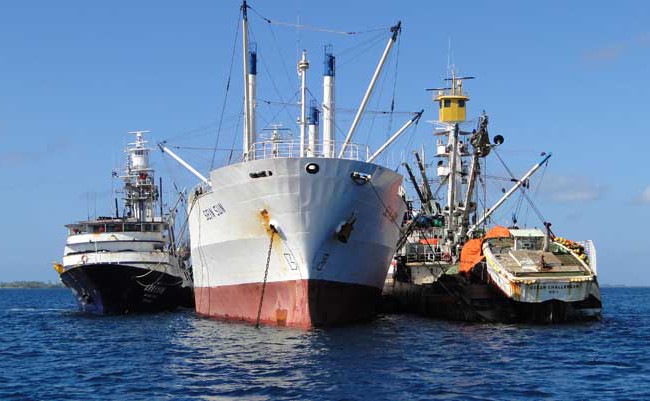
Pacific unity is paying off – in fisheries at least
As Pacific islands ratchet up control of fishing in their waters, we’ve seen a predictable response from distant water fishing nations.
When the Western and Central Pacific Fisheries Commission (also known as the ‘Tuna Commission’) was established by treaty 10 years ago, the Japanese government, despite its active participation in negotiations leading up to the treaty, refused to sign on at the first opportunity. Despite being part of the negotiations, it said it wouldn’t back the newly established regional fisheries management organization for the Pacific. Was it unsurprising that a year later, Japan signed on?
The Parties to the Nauru Agreement (PNA), which has set itself up as a fisheries cartel, established a vessel day scheme for selling fishing days, with the goal of limiting the then-uncontrolled level of purse seine fishing to conserve tuna and increase its value. PNA has certainly been successful in the latter (tuna revenue flowing to the eight member nations has risen from US$60 million annually in 2010 to over US$250 million last year), if not as successful at the former.
But when PNA started enforcing the vessel day scheme, most distant water fishing nations balked at accepting it. They had been used to sending fisheries teams to island capitals once a year to negotiate license fees, which historically paid just pennies compared to the profits reaped by the fishing countries. These countries were not about to change a style of operation that had fed their fishing industries for two generations. Now, with the exception of the European Union, all distant water fishing nations with purse seiners operating in the region are fishing under the vessel day scheme. Shall we take bets on the EU’s ultimate acquiescence to the vessel day scheme?
Then there are the Americans, who have enjoyed preferential access to PNA waters since the late 1980s, when a U.S. State Department-backed fishing treaty came into play with all Forum Fisheries Agency islands. The treaty ended years of U.S. flagged boats fishing without paying, ignoring rules, and generally giving the U.S. a bad name in the region. When the treaty’s financial package came up for renegotiation several years ago, the U.S. was paying US$21 million annually. The PNA demanded triple this amount. ‘It’s too much,’ said U.S. negotiators. ‘We can’t pay it.’ Over the ensuing years of negotiation the U.S. side finally agreed to pay $63 million a year, a deal that went through in 2013. Now PNA has upped the access ante because it is increasing the fishing day fee from US$6,000 to US$8,000 come January 1. And the U.S. has tentatively agreed to US$87 million a year to secure fishing access for it vessels. ‘Can’t afford it?’ The better question is, ‘do you want to keep fishing?’ And the U.S. government and industry clearly know the answer to this question.
With it now clear that bigeye tuna are being over-fished, the move for greater control of the longline fishing industry is gaining momentum. Since the 3,000 longliners plying the Pacific generally fish on the high seas, they are more difficult to manage than the purse seiners that fish ‘in-zone’. Still, PNA has announced plans to extend a vessel day scheme to longliners to bring it under the control and management of Pacific islands.
As pointed out last week at a fisheries meeting by Phil Roberts, the managing director of global tuna supply company Tri-Marine International, ‘When PNA banned high seas transshipment for purse seiners, there were some grips. But then everyone started doing in-port transshipment.’ In-port transshipment meets dual conservation and economic development goals for Pacific islands: it increased the opportunity for monitoring vessel catches, while offering numerous spinoff economic benefits to Pacific ports. One of the key proposals on the table is to halt longliners trans-shipping on the high seas, which is where virtually all of the distant water fishing fleet currently off-loads its catches of tuna—a system that is problematic for effective fisheries management and producing accurate stock assessments.
The longline industry of Japan, S. Korea, Taiwan and China is not helping matters, either. The fact that these four nations have, since the start of Tuna Commission a decade ago, failed to provide operational catch data that is a requirement of membership appears finally to be coming to a head. The 17-member Forum Fisheries Agency (FFA) issued a strongly worded statement in August calling for action by these four nations to provide data to reduce gaps in stock assessments. An increasing number of Pacific fisheries officials want the Tuna Commission to sanction these countries for failure to provide the required data.
History tells us that if island countries stay unified, they can gain control over an industry long dominated by distant water fishing nations. Enforcing ‘best practice’ management rules is the only way to ensure the future viability of tuna stocks not only for Pacific islanders, who depend on this for food security, government services and jobs, but for the rest of the world that is increasingly dependent on tuna fish as a food source. The fact that distant water fishing nations have had to be forced, sometimes kicking and screaming, by the PNA, FFA and the Tuna Commission to comply with changes to sustain and stabilize the industry, while sharing the benefit with island nations, simply underlines the point that unity works.
The PNA and FFA have proved over the years that there is power in numbers. It’s an example of success for the region that could easily be applied to other economic areas, including deep-sea mining.

